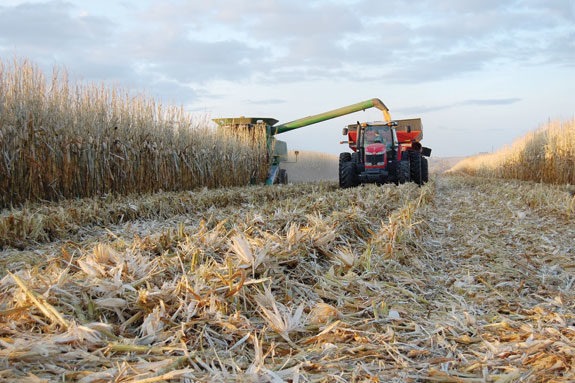One thing that hasn’t changed: silage fermentation.
Fermentation, a biological process that involves creating an anaerobic – oxygen-free – environment, is desirable for at least two reasons: To preserve nutrients in an effort to optimize livestock intake and performance and to minimize spoilage.
Not accomplishing these goals will lead to the opposite – loss of nutrients that could adversely affect livestock performance and health.
McIntyre, dairy manager of Deruyter Dairy in Marsing, Idaho, says that between his two jobs – one as a forage grower, the other as a dairyman – he’s learned a few things over the years that has helped him achieve success fermenting silage.
Luck, such as good weather, has little to do with good fermentation and everything to do with proper management.
“I think we’ve got it pretty well figured out,” McIntyre says. “The biggest thing is moisture – not getting it too wet. Keeping it at about 65 percent moisture is our target. If we err on the side of preservatives, we err on the heavy side.”
McIntyre works with bunker silos that hold between 18,000 tons and 50,000 tons of silage, but achieving proper moisture content and packing holds true for growers of any scale. He applies inoculants to the forage during harvest to make sure they’re distributed evenly – and once the forage is cut, he packs it right away.
“What helps us make some awesome feed is getting it packed in the pit very, very good,” he says. “We do not skimp on iron on top of the pit. We just pack the living daylights out of it. And then we use a heavy plastic to cover the silage. We cover it very quickly.”
The presence of oxygen during the fermentation stage can spoil a good crop. Growers and buyers can prevent many problems if they take a look at how they’re packing their silage.
“There’s a whole range of things to know in order to make good silage,” says Joel Bagg, forage specialist with the Ontario Ministry of Agriculture. “You harvest the crop, chop it up, make it anaerobic, pack and seal it to remove oxygen.”
The most common problem with fermentation, he says, is inadequate packing.
“It is, therefore, not anaerobic, which leads to poor fermentation, losses and spoilage,” Bagg says. “Another common problem is butyric acid from harvesting at too high a moisture and soil contamination.”
In the case of butyric acid, also known as clostridial fermentation, Richard Muck, agricultural engineer with the U.S. Dairy Forage Research Center, USDA-ARS, in Wisconsin, says hay silages put up too wet is another common problem.
“For us in Wisconsin,” he says, “ensiling alfalfa at less than 65 percent moisture usually guarantees a successful fermentation.”
That’s the same target goal that McIntyre uses in Idaho.
Is the process foolproof? Not by any means, for Bagg says even with good fermentation, losses can reach 12 to 15 percent. But that’s better than higher numbers, which come from poor fermentation. Your goal as a grower should be to reduce as much loss as possible.
How do you know if your silage is fermenting properly? You already have one tool that can help you detect problems: your nose.
Odors can be good indicators there might be problems with fermentation, Bagg says. Let your schnoz help you by paying attention to rancid, fishy, vinegar, moldy, sweet, ammonia and tobacco odors during fermentation, which takes at least three weeks.
Because proper packing is so essential in the fermentation process, a continued area of research is on minimizing the exposure of silage to oxygen.
One area of research is on plastic films that better keep oxygen out of the silo. Improved packing of bunkers and piles also are topics of continued research, he says.
But there’s still another problem that can lead to spoilage: heating in the feedbunk.
“Again the problem is oxygen exposure, and the preventative measures are the same – high density, good cover and high feedout rate with the two additives – lactobacillus buchneri or propionic acid – supplementing,” Muck says.
“Many producers are making good strides toward improving density and covers. Probably the biggest challenge is getting feedout rates to average six inches or more a day off the whole face. That comes down to designing bunkers and piles properly.”
Something else McIntyre suggests: “We use a silage rake every day to keep the face [of the silo] nice and clean and straight; it helps to eliminate as much spoilage as possible there, too,” he says. “A jagged face has a lot more exposure to oxygen than a nice, groomed face.”
Don’t get discouraged if your silage isn’t up to expectations. Part of being a forage grower is learning from past mistakes and improving upon them in the years ahead, Bagg says.
And if current trends are any standard, then the future looks bright for forage growers and dairymen because of continued research by nutritionists and education of growers.
More growers today are managing their crops better than they did even 10 years ago, says Stan Force, president of Litchfield Analytical Service in Litchfield, Michigan. They’re better educated about fermentation and the consequences for not doing it properly.
“That has changed a great deal,” he says. “In some cases years ago, growers were losing possibly in excess of 25 percent of their forage.
Now if you talk to a grower that has 500 acres, and ask him if you could go out and dig up 125 acres before harvest, he’d kind of get upset.
But back then it’d be nothing for him to put it into silos and allow 25 percent of it to spoil … Once [today’s grower] understands that he’s doing the equivalent of that by not following a good process, he’s willing to buy in. ‘Yeah,’ he says, ‘I’m going to pay more attention to the details.’
“It’s important to have the right moisture content,” Force continues. “If silage is too wet, it doesn’t ferment well. If it is too dry, it does not pack well … Is every grower firing on all cylinders?
No, but those that were firing on one cylinder 10 years ago are probably firing on four today, and those that were firing on four 10 years ago are now firing on seven. And we now are seeing better-quality forages than we used to because of it.” FG
Weeks is a freelance writer based in Twin Falls, Idaho.
PHOTO
The McIntyre family grows both grain and silage corn on their farm in Caldwell, Idaho. Photo courtesy of the McIntyre family.











